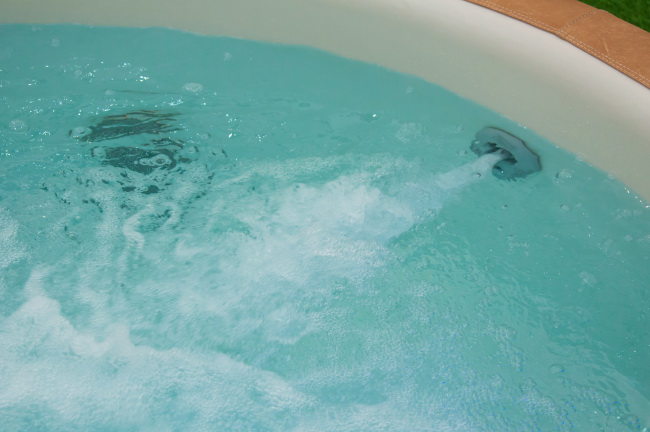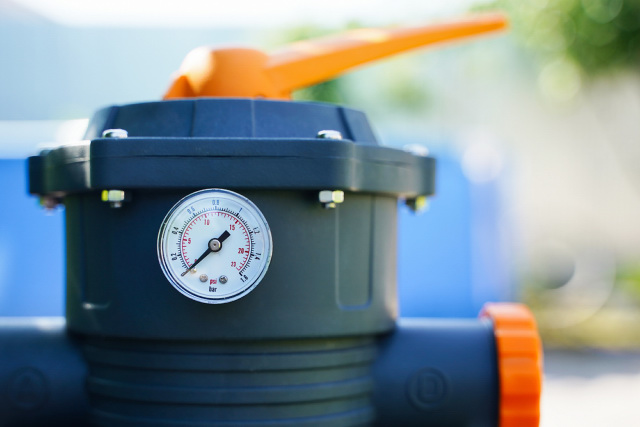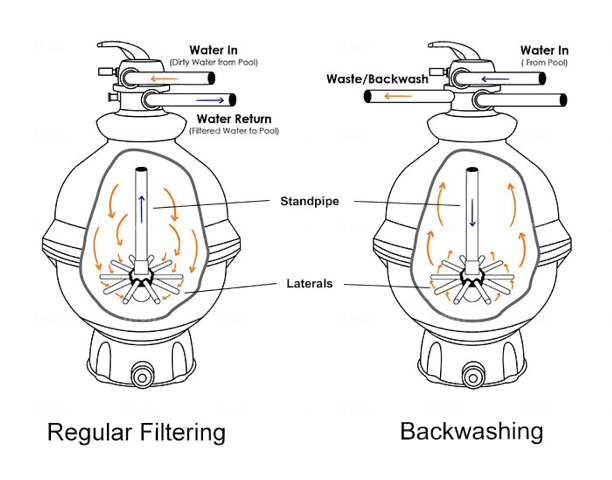Accidentally adding too much DE to your filter isn’t an uncommon mistake. However, once you notice your error, it’s important to remove the excess to prevent any lasting damage to your filtration system.
So, how do you remove surplus DE powder?
The easiest and quickest fix to remove excess DE powder from your filter is to backwash it. But, when backwashing your filter, make sure to do it in small bursts at a time so you don’t accidentally clear too much powder out.
Before we dive into the best practice to remove excess powder, let’s have a look at some of the signs of adding too much DE and the reasons for surplus DE powder, and its potential repercussions.

Article Contents
Signs You’ve Added Too Much DE
If you think you’ve added too much DE powder, here are a few symptoms to look out for:
- DE in the pool
- DE coming out of returns (jets)
- High filter pressure
Why is There Too Much DE Powder in My Filter?
The primary reason there’s too much powder in your DE filter is a miscalculation of how much you needed to add.
How much DE powder you need to add to your filter depends on the size as well as your needs. There is a difference in how much to add between:
- New installations
- New filter grids
- After backwashing
If you are installing a new filter or replenishing powder after its yearly clean, follow the full recommended dosage found in the manufacturer’s owner manual.
If you don’t have access to the manual, you can use the recommended doses for popular filter sizes below.
Whereas, after backwashing the filter, you only need to add 80% of the recommended dose. This is because a backwash doesn’t rid the filter of all powder, only old and some lodged clumps.
Related Reading: How to Remove Excess DE from Pool Floor
How Much DE Powder Do I Need?
Before you add DE powder to your pool, you’ll have to find out how much you’ll need. And, factor in whether you’re topping up or refilling.
For easy reference, some of the most popular DE filter sizes are below:
| DE Filter Size | After Backwashing | After Full Cleaning/New Filter Installation |
| 24 sq. ft (2.2 sq. m) | 1.9 lbs (0.8 kg) | 2.4 lbs (1.1 kg) |
| 36 sq. ft (3.3 sq. m) | 2.8 lbs (1.3 kg) | 3.6 lbs (1.6 kg) |
| 48 sq. ft (4.5 sq m) | 3.8 lbs (1.7 kg) | 4.8 lbs (2.2 kg) |
| 60 sq. ft (5.6 sq m) | 4.8 lbs (2.2 kg) | 6 lbs (2.7 kg) |
| 72 sq. ft (6.7 sq m) | 5.7 lbs (2.6 kg) | 7.2 lbs (3.3 kg) |
As you can see, backwashing doesn’t need quite as much DE powder.
Although there are different ways to measure the right amount of powder, most pool owners prefer to use a DE scoop as it gives them a more accurate measurement than using scales or a coffee can.
Effects of Too Much DE Powder Added To Filter
When there is too much DE powder in your filter, the effects include high-pressure gauge readings and undue strain on your pool pump. If left untreated, it could cause the filter to rupture and damage your surroundings or yourself.
Most pool pressure gauges range from 5-15 psi or 10-20 psi so knowing your filter’s baseline pressure is important in helping distinguish if it’s too high or low.
The easiest way to find the baseline is to note the pressure after backwashing. Make sure to empty the skimmer and pool baskets too.
If the psi is more than 10 psi higher than your baseline filter pressure, it’s time to figure out what’s going on. Many pool owners mark their filter’s normal pressure with a marker on the pressure gauge. Or, some gauges let you set a ‘clean’ range and ‘dirty’ range.
Regardless of whether the gauge is high or low, it means that there’s a water flow problem.
A handy rule of thumb is if the pressure reading is low, there’s a blockage or flow restriction within the pump or before it. Whereas, if the pressure is higher than normal, the blockage or restriction lies somewhere after the pump (i.e., the filter).
There are multiple potential reasons why the pressure gauge is reading high (and you can check them out here): ‘8 Reasons Filter Pump Pressure is High (And How to Fix)‘.
Checking your pressure gauge weekly is ideal to make sure it’s staying in its normal range. If the pressure builds too high, not only will the filter and pump stop working properly, there’s a risk of filter explosion.
- Further Reading: 7 Tips to Prevent Pool Filters Exploding
When starting your DE filter, keep an eye on the gauge and a hand on the switch. If the pressure spikes up to 30 or more psi, shut it off immediately and investigate the cause.

Effects of Too Little DE Powder
The main effect of low DE powder is the reduced ability of your filter to clean your pool efficiently. Without enough DE, dirt will easily slip through the filter grids and re-enter the pool.
DE powder is incredibly powerful at filtering out the smallest of particles. But, this all depends on how well coated the filter grids are.
So, without enough coating, the dirt, debris, and other organic matter won’t be filtered out. This in turn leads to cloudy water and higher chlorine demand. In other words, you’ll need more chlorine.
So, if you notice that your pool is cloudy or showing a low-pressure gauge reading, it’s time to investigate the cause. It could be too little DE or it could be other issues with the filter.
How To Remove Excess DE from Filter
The best way to remove excess DE powder from your filter is to backwash and then top it with powder afterward if necessary.
When you’re performing a backwash to clear surplus DE powder, make sure to do it in small bursts. Otherwise, you’ll run the risk of flushing out all the powder and costing you more money to refill.
Steps to Remove Excess DE from Filter (with a multiport valve):
- Turn off the pump.
- Then, move the multiport valve (MPV) lever to Backwash.
- After, turn the pump back on and let it run for 30-60 seconds.
- Then, turn off the pump.
- Move the MPV lever to Rinse.
- Turn the pump on and let it run for 1-2 minutes.
- Then, turn off the pump and move the MPV lever to the Filter.
- Start the pump and check the pressure gauge.
Normal Pressure: You’re done. You’ve added enough DE.
Low Pressure: Top up with a small amount of DE. Check the pressure again. Repeat the process until the pressure is normal.
High Pressure: Backwash again, check the pressure, and repeat if necessary. - Lastly, turn on the pump and let it run for 30 minutes so the DE can coat the grids properly.
To backwash your filter (with a push-pull valve):

- Turn off the pump.
- Open valve to Backwash.
- Turn on the pump and allow it to run for 30-60 minutes.
- Then, turn off the pump and close the push-pull valve.
- Start the pump and check the pressure gauge.
Normal Pressure: You’re done. You’ve added enough DE.
Low Pressure: Top up with a small amount of DE. Check the pressure again. Repeat the process until the pressure is normal.
High Pressure: Backwash again, check the pressure, and repeat if necessary. - Then, turn on the pump and allow the filter to run for 30 minutes so the powder can properly coat the grids.
If you’re curious how often to backwash your filter, check out our article here for more info: ‘How to Backwash a Pool Filter & How Often‘.
Final Thoughts
Commonly thought of as the superior filter type among pool owners and experts, DE filters still aren’t completely free of faults. And, one of those faults is the easy miscalculation of how much DE powder to add.
If your filter contains too much powder, it can have damaging and even catastrophic aftereffects to the pump and filter body.
Luckily, backwashing your filter in short bursts will help remove excess DE powder and return your pressure gauge reading to normal.
Related Reading: Why is There DE on my Pool Floor and Coming Out Jets?


